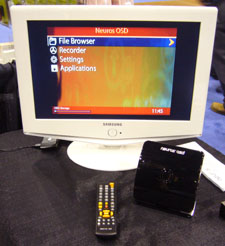Despite Amtrak breaking down and delaying my return, I made it home safely though fatigued. I’m not sure if less vendors attended DigitalLife this year, or if less vendors I cared about were present. Overall, I wasn’t very excited about most of the tech on display (other than the Dash) and am glad I only took one day for the event.
 Two products in particular appealed to me as a geeky consumer — though I question their viability in the commercial marketplace.
Two products in particular appealed to me as a geeky consumer — though I question their viability in the commercial marketplace.
First up is the revamped Neuros device, known as the OSD. The Neuros OSD is primarily designed to encode video, from whatever source you choose, and save it as an unprotected MPEG-4 onto a variety of memory cards or devices (PSP, iPod). The networked device also has the ability to playback this video at up to DVD resolution. But where it gets really interesting is that the OSD is open-source (Linux) and Neuros is offering cash bounties to developers who extend the feature set. For example, an EPG and Skype integration are in the works.
Next, ITVN caught my eye. They offer a small, networked box that streams video from the Internet. Their primary content partner is Starz! For $14.95/mo you have access to 15 channels of live programming in addition to VOD. Movies are not stored locally — it truly is live streaming. In the case of VOD, it didn’t sound like you could pause the feed though you can skip to different chapters (like a DVD) within a flick. They also have an interesting angle in selling targeted programming options: for example LacrosseTV @ $10/mo and Late Night (adult) @ $30/mo. The quality looked to be about SD in resolution, though the rep says it’s higher. We agreed the major obstacle would likely be the speed of your home Internet connection.

Sony had the most interesting tech on display, and I’m not talking about the playable Playstation 3’s or the humongo televisions. This was the first time I was able to see the Reader, Mylo, and LocationFree Receiver in person. The Reader is a little quirky, but the screen defies description. I have never see anything like it, and they aren’t kidding when they say eInk looks like print: I thought the units on display were non-working samples until I hit page forward. The button layout is a bit strange, there’s no backlight, and it could really use a hand strap… but this is worth keeping an eye on. The Mylo is a cute little handheld for IMing on WiFi around the house, though the keys are small and squishy. If they add a POP email client, I could see picking one up. It also has a variety of media functionality, though there are better choices out there. Lastly, I got to check out Sony’s updated LocationFree line (think Slingbox). The shiny black Sony boxes beat Slingbox in style hands down, but Sling’s software is superior and, at the end of the day, that takes precedence. However, Sony offers a LocationFree receiver for about 200 bucks that allows you to control (via remote!) and stream content to another television. I hope Sling has one of these in the pipeline, because it will move units — most of us still prefer to watch TV on TV.
Additional coverage:
I too was at DL2006. I was very much impressed wtih the Sony Reader. I thought that it was a demo screen because it look amazing. I want one to read tech manuals in PDF but Sony said they might not look so good. I have a feeling unles it is designed for the device nothing is going to look that great.
Again, I say, what use is ITVN without better/more content deals? Am I really going to add a secondary VOD service (and set-top) on top of my existing cable or telco package?
What, ITVN’s porn isn’t good enough content?
Seriously — I do agree it has limited commercial appeal in its current form. They probably can’t secure better/more content deals until they reach a certain subscriber threshold… assuming they’re willing to give the vast majority of the profits to those content owners (most who’ve been reluctant to go down this path so far). So it’s a chicken v. egg scenario: How do you get the subscribers without the content? How do you get the content without subscribers?
From a technical standpoint, they need to add a buffer that I can control (pause, rewind, fast forward) otherwise we’ll be giving up capabilities many already have with a cable or sat box. Also, early adopters probably aren’t interested in SD content. We want HD. How are they going to do that over my slow DSL link without any local storage?
One thing in their favor is a smart marketing strategy of paying out a $50 bounty on each box/service sold. This may get some businesses (both online and off) to push the product. Hm, maybe ZNF should be an ITVN reseller.